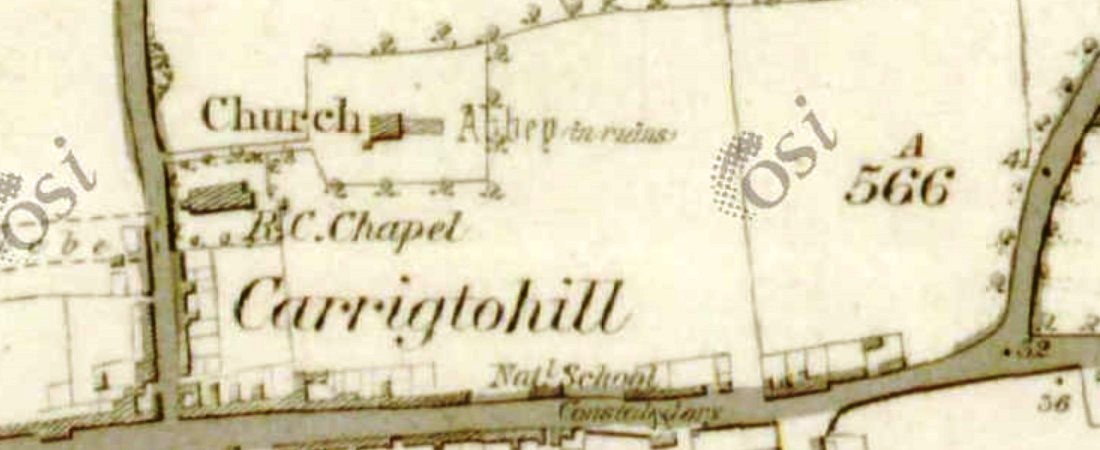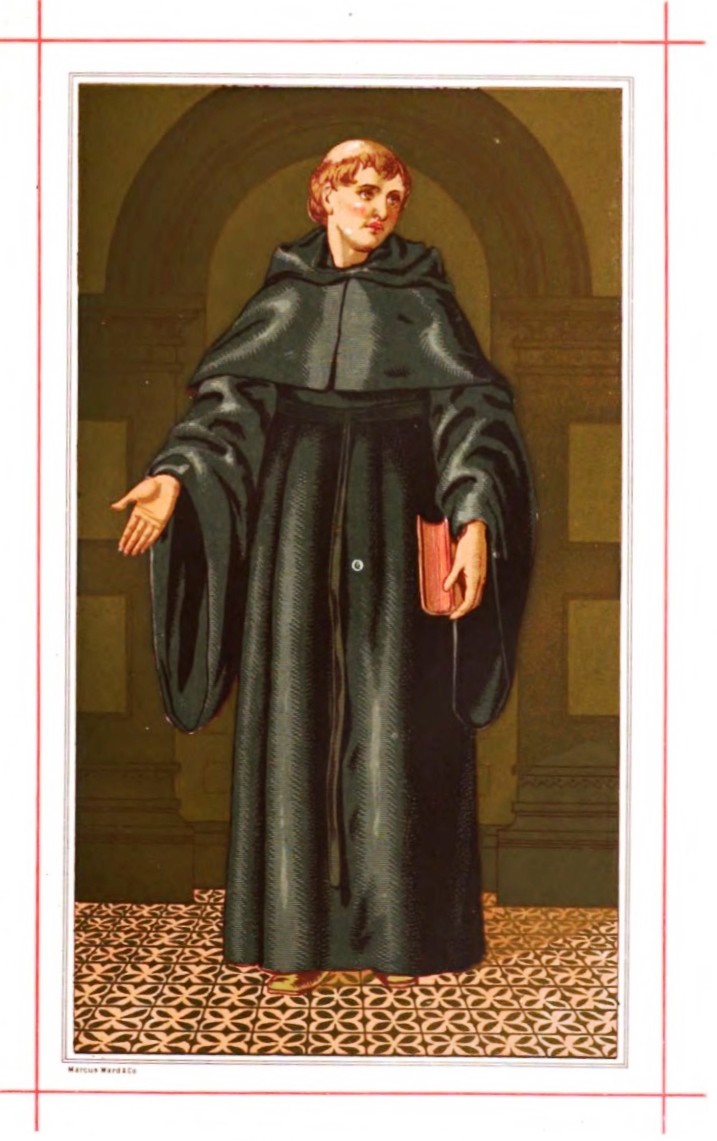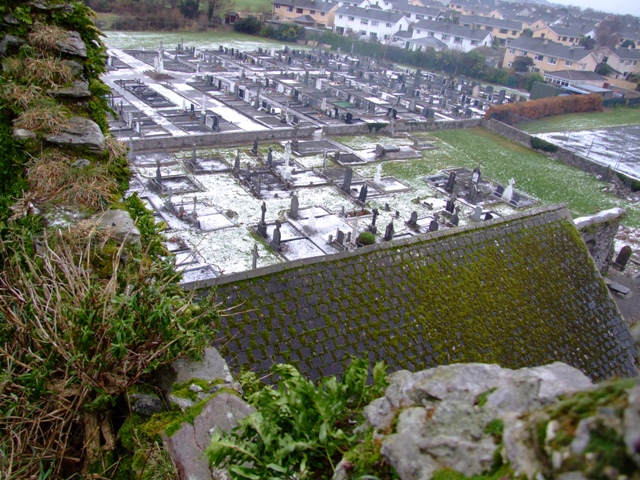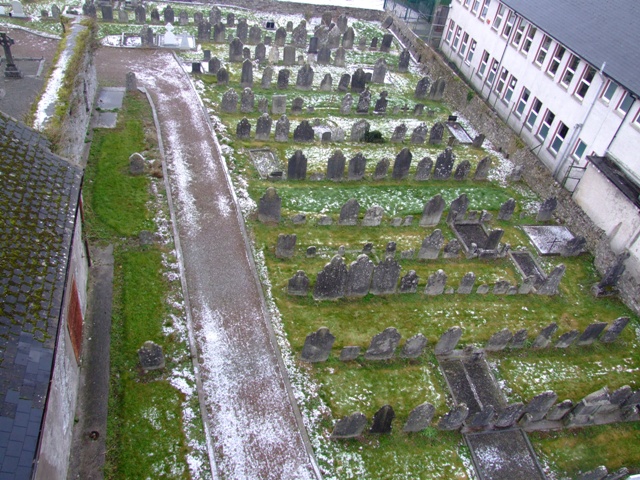Religious of the Parish
Abbey Ruins & Original Village Cemetery
Abbey Ruins
The origins of the village Abbey ruins has long been somewhat of a mystery, believed locally, in error to have been
a Franciscan establishment, built and endowed by the Earl of Barrymore who also established an Abbey at Buttevant
of the same Order. This belief was most likely based upon Samuel Lewis’
Typographical Directory of Ireland
of 1837 who never visited Ireland at this time, states;
“… Near the village are found the ruins of a Franciscan abbey, founded and endowed by the Barry family: one of its
towers serve as a steeple for present parish church, which, and the Roman Catholic chapel, are erected on its site;
there are several detached portions of the buildings remaining, but they are rapidly falling to decay….”
Samuel Lewis was further in error when he says the 'R. C. chapel' had been erected on the Abbey grounds. Whereas in
fact, the Catholic Church stood on its own ground held in perpetuity by
Thomas Forest (Forrest), built circa, 1818, by Rev. Matt Horgan, the then Parish Curate.
As a consequence of the dissolution of the monasteries (1536 -1541) by Henry VIII, all religious property became the
possessions of the British Crown, and confirmed in the publication, Monasticon Hibernicum,
it is docmented that ‘Carryketwohill’ [Carrigtwohill] and 'Kylcarryhyn' [Kilcurfin] were seized by him, which, in
subsequent generations had been granted advowsons (ecclesiastical law to patronise - sponsor) the churches of Carrigtwohill
and Kilcufin to deserving Knights of the Crown.
Then, from 1676 through to 1840, Rev. Dr. William Maziere Brady, in his research published as the Parochial Records
of Cork, Cloyne, and Ross, 1864, documents that the patronage of these two churches alternated between Lord Barrymore
and the Bishop of Cork.
Lady Georgina Fullerton, in her essay published in the ‘Irish Monthly' of 1876, concerning the new village convent,
correctly comments on the unknown origins of the structure. Lady Georgina being a lifelong friend of Mother Magdalen
Taylor.
“Just beyond the churchyard walls is seen in the distance an ancient picturesque building, once the Catholic church
of Carrigtwohill. A conventional one, tradition says, though of what order there is no clear record. It fell, of
course, into the hands of the Protestants, and some of the additions which have propped up the old walls would
have disfigured them but for the friendly Ivey which covers the whole building with it green mantle.”
The below OSI map clearly outlines the boundaries of the Abbey grounds incorporating St David’s Protestant Church,
St Mary’s Catholic Church grounds, and the field bordering both. This map is not the one used for the Griffith’s
Valuation of 1852 for Cork, showing the railway; the contract of which the construction of line between Dunkettle and
Midleton was not awarded until December 1854 to ‘Messrs Moore Brothers’ as reported by Cork Examiner. Therefore, must
predates the arrival of the railway.
The Abbey and St Mary’s Church boundaries exist to this day. At some point between this map being issued and the
one used for the Griffith’s town plan, the adjoining field was split in two. Then in more recent years the laneway
leading to the Abbey ruins and St David’s Protestant Church was moved further north to accommodate the building
of Glenmary Hall.

The Down’s Survey shows the ruins, but does not name it. Then, William Wilson (topographer.) 1786 gives a brief
description of the village, but fails to mention the ruins, yet in his more detailed description of Midleton about six
miles away, he fully documents the Cistercian Abbey, then in ruins, but today little sign of it exists. Charles Smith’s,
The Ancient and Present State of the County and City of Cork, 1815, gives a full description of Carrigtwohill. He too
fails to mention the village ruins.
Father Joseph MacMahon, OFM, the Franciscan’s historian of Ireland’s Provincial Administration Office Dublin, recently
advised us;
"Over many years of research into the history of the Irish Franciscans I have never heard of a foundation in Carrigtwohill.
I’ve also consulted the sources and there is no mention whatsoever of a Franciscan foundation there. Officially, we refer
to each foundation as ‘friary’ and never as ‘abbey’. The term ‘abbey’ has stuck to some only because the local people
referred to them as such."
Augustinian Abbey
 Augustinian Monk or Abbott
Augustinian Monk or Abbott
Our own recent research would strongly suggest the ruins were that of the Augustinian’s satellite place of
worship whose head Abbey was at Ballybeg, near Mallow, which we now document.
Firsly, the Kilkenny Archaeological Society published a report in their 1852 issue where it was claimed the Dr. Smith
description of Ballybeg was ‘manifestly in error’ which they corrected taken from manuscripts of the time of Abbey's establishment;
“…. For we find in Lodge’s ‘Peerage’ that David de Barry was possessed of the lordship of Buttevant at that
period, and that he was not the son of William but Robert, whom he succeeded. It is true that William was
the eldest son and heir of Phillip de Barry; but, being a favourite of king John, he resided in England,
and is supposed to have assigned his Irish estate to his younger brother, Robert, as is thus set forth by
Lodge:-
In 1229 he [Phillip de Barry] endowed the friary of Ballybegg, in the county of Cork, in memory whereof,
his effigies on horseback was cast in brass set up in the church there…
He left issue two sons, William and Robert; to the eldest of whom king John confirmed his uncle’s said gift
of lands by patent, dated at Woodstock, 21st February, 1208; in which king’s reign (it is said) he was one
of the Recognitores Magnae Assisae for the county of Kent, and living at the Moate there, where several of
his successors, who were Lieutenants of Dover Castle, and Conservators of peace in that county, had their
residence. – If this be fact, he probably assigned his estate in Ireland to his younger brother, Robert de
Barry, who appears to be possessed thereof by the bequest he made in honour of God, the blessed Virgin, and
St. Thomas, of on Mother Church upon his land, and one carucate near his castle of Robertstown.
He had issue two sons, David, his heir, and Phillip Barry.
The history of the Abbey was further documented within the Monasticon of Hibernicum, by
Mervyn Archdall for the Royal Irish Society, and Chaplain to the Right Hon. Francis Pierpoint, Lord Conynghan,
published 1873. The items specifically relating to Carrigtwohill may be read by clicking on
Monasticon of Hibernicum link.
It remains unclear if our ruins were of a church or
Abbey.
The following three extracts are taken from the Calendar of the Patent Rolls of the Chancery of Ireland
for James VI of Scotland, who became King of England and Ireland in 1603 as James I.
|
Calendar of the Patent Rolls of the Chancery of Ireland |
|
3rd Year of reign |
5th Year of reign |
8th Year of reign |
|
“Inquisition, 5th February, III. James I., finds that, 28th April, XVI, Elizabeth, a grant for
a term of years was made to George Bourcher, Esq., of this priory and the demesne thereof, with
certain lands in the town of Ballybeg; as also the rectories of Ballybeg, Ballikeran, Ardhoile,
and Rathbarry, Ballyclogh and Ballycastell, Crustmalyny in MacWilliam’s county, Carricktwohill,
Castlebechin, Kill __ Kilnemallagh, Rosseghe, Downeragill, and Chairdowgab, in the counties of
Cork and Mayo. To hold the same at the annual rent of £41 10s. Irish money.
David de Cardigan was prior in the reign of King Henry III. and John de Barry in the following
reign.
The possessions belonging to this house were, in the 16th
year of Queen Elizabeth, granted for the term of 21 years to George Bourchier., who forfeited the same by non-payment of the rent;
those lands and tithes were granted in trust to Sir Daniel Norton, for the wife of Sir Thomas Norris,
president of Munster, and were found, in the year 1622, to be of the yearly value of £260.
Of this abbey there yet remain the east window and a steeple, which is a strong building, and by the holes
in the vaulted roof it appears that they had a chime of bells; and traces of the foundation, with
an high tower a conciderable way to the southwest, prove it to have been a truly magnificent structure.”
|
“LIX. – 21. Pardon for an alienation made without licence by sir Daniel Norton to sir John Jephson and
dame Elizabeth his wife
--- Cork Co. The site, &c. of the dissolved abbey of Ballibegge, containing about 1a,
together with 60a arable and pasture of the demesne thereof – in Ballibeg, 150a arable
and pasture – the rectories of Kilkeran, Ardophiell, otherwise Ardafoile, Kilgarowph,
and Rathbarry, the rectories of Ballinclough and Ballicastell, the rectory of Cloneferty,
Killorout.
--- Conaught Provs. In McWilliam Eighter’s county. The rectories of Cresscrulyne,
otherwise Crusemnullyne.
--- Cork Co. Carrutwohill, Kilculeyhine, and Liscorelle, the rectories of Castleighan,
otherwise Castlebegan, and the rectories of Killenallaghe, otherwise Buttevant and
Liscarowle.
--- Cork and Mayo Co. The rectories of Russaugh, otherwise
Rossaugh, Downershill, and Cahirdowgan. All being the lands of the said Abbey; together with all castle lands,
&c. to the same belonging in the counties aforesaid; demised 29 Nov. 26th Eliz. To Stephen Walters of Cork,
gent. For 40 years, at the expiration of a grant, dated 28th Apr. 16th Eliz to sir Geo. Bouchier, Knt, for 21
years; woods, wards, escheats, mines and minerals, and other casualties excepted. – 11 Jun. 5th.”
|
“XIL. – 12. Grant from the King to sir John Jephson, knt, privy councillor. – Cork Co. The site, &c. of the late
abbey or monastery of Ballybeg – the town, lands, and rectory of Ballybeg – the rectories of Kilkerran otherwise
Kilkerranmore, Ardophiell otherwise Ardophoyle, Kilgarowphe, Rathbarry, Balcklough otherwise Ballycloughy, Ballycastle,
Castlemanger, Carricktwohill otherwise Carutwohill, Kilkullchine, Kilcurrehine, Liscorrell otherwise Liscarrule,
Castleleighan otherwise Castlebegan, Buttevant otherwise Killmallagh, Russagh otherwise Rossaugh, Downeraile,
Caherdowgan, Bregoge Dromdoney, Kilbrine, Kilmaboe, Roskyne, Carkarre, Croghe,Kiltauny, Lisgowle, Gortacrough,
Helford-tan, and Castlemagighie. --- Mayo Co. The rectories of Clonfertie, Kilvromte otherwise Kilvrone,
Crassernelyme otherwise Crossemullyne otherwise Crusemullyn in McWilliam Eighter’s country; the estate of the
abby of Ballibeg; with all the tithes, &c. – Total rent 81l 102 0d Ir. – To hold for ever, as of the castle of
Dublin, by fealty only, in free and common soccage, in consideration of his service to Q. Eliz. and that he had
released to the Crown all debts and sums of money, which he or Eliz. his wife did or might claim as executor to
sir Thomas Norris, knt, or Eliz. his wife, deceased – to find and maintain upon the premises, two able horsemen,
well armed, for the defence of the kingdom; also repairing chancels of churches, paying proxies, synodals, curates’
stipends, and other services, ordinary and extraordinary. – 21 Apr. 8th.”
|
Old Village Cemetery
The following is a extract of T Gragoe's article of Penhellick, published by the West Briton & Cornwall
Advertiser, 22nd December 1870, for the Royal Institute of Cornwall entitled “Recollections of
Remarkable Burying Place”;
“Near the village of Carrigtwohill, in the county Cork, are the extensive ruins of the religious house, and close by a
graveyard which no stranger ever forgot. A sea of gravestones. Surely no man ever saw so many in one place before. Some
were six and seven feet high, and all venerable with age. Perhaps in England, which has been a Protestant country so long,
a truly ancient place of this kind is rarely seen. This struck me forcibly at the time. These stones seemed to guard no
particular space, being nearly as close together as they could stand, and at all angles. Some were upright, others were
prone -- here three colossal slabs, side by side, were leaning forward in a line, whilst those in the advanced rank were
sloping backward to meet them. The abbey roof and every vestige of it had long mouldered to decay, but the walls were still
standing, and you might yet see, from the grim workmanship of the deep-wrought windows, that the men who built that
edifice meant it to weather out all time. The tower was crowned with ivy; and, alone in the twilight, I thought I could
almost fancy the monkish head of some old “Father Abbot” peering over the top”
He was very likely Thomas Adolphus Gragoe, but further research is required to confirm.
The original village cemetery is located within the boundary walls of the ruins of the
Augustinian Canon Abbey. The southside abuts St Aloysius College, and Convent. This is
illustrated by the photographs taken by Ollie Sheehan from the top of the Abbey tower
during a recent survey.To the north and outside the Abbey boundary is the current village
cemetery.
 Cemetery Northside of Abbey
Cemetery Northside of Abbey
|
 Cemetery Southside of Abbey
Cemetery Southside of Abbey
|